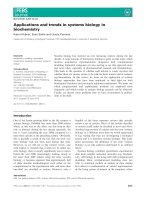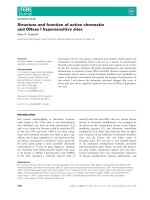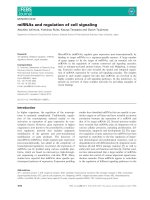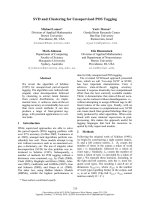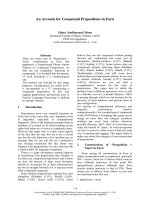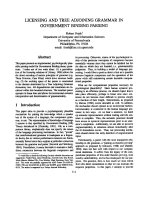Báo cáo khoa học: "Conceptual and Linguistic Laurence Decisions in Generation" docx
Bạn đang xem bản rút gọn của tài liệu. Xem và tải ngay bản đầy đủ của tài liệu tại đây (277.83 KB, 4 trang )
Conceptual and Linguistic Decisions in Generation
Laurence DANLOS
LADL (CNRS)
Universit~ de Paris 7
2, Place Jussieu
7S00S Paris, France
ABSTRACT
Generation of texts in natural language requires making
conceptual and linguistic decisions. This paper shows first that
these decisions involve the use of a discourse grammar,
secondly that they are all dependent on one another but that
there is a priori no reason to give priority to one decision
rather than another. As a consequence, a generation
algorithm must not be modularized in components that make
these decisions in a fixed order.
1. Introduction
To express in natural language the information given in a
semantic representation, at least two kinds of decisions have to
be made: "conceptual decisions" and "linguistic decisions".
Conceptual decisions are concerned with questions such as: in
what order must the information appear in the text? which
information must be expressed explicitly and what can be left
implicit? Linguistic decisions deal with questions such as:
which lexical items to choose? which syntactic constructions to
choose? how to cut the text into paragraphs and sentences?
The purpose of this paper is to show that conceptual
decisions and linguistic decisions cannot be made
independently of one another, and therefore, that a generation
system must be based on procedures that promote intimate
interaction between conceptual and linguistic decisions. In
particular, our claim is that a generation process cannot be
modularized into a "conceptualizer" module making conceptual
decisions regardless of any linguistic considerations, passing its
output to a "dictionary" module which would figure out the
lexical items to use accordingly, which would then in turn
forward its results to a "grammar", where the appropriate
syntactic constructions are chosen and then developed into
sentences by a "syntactic component". In such generation
systems (cf. (McDonald 1983) and (McKeown 1982)), it is
assumed that the conceptualizer is language-free, i.e., need
have no linguistic knowledge. This assumption is questionable,
as we are going to show. Furthermore, in such modularized
systems, the linguistic decisions must, clearly, be made so as
to respect the conceptual ones. This consequence would be
acceptable if the best lexical choices, i.e., the most precise,
concise, evocative terms that can be chosen, always agree
with the conceptual decisions. However, there exist cases in
which the best lexical choices and the conceptual decisions are
in conflict.
To prove our theoritical points, we will take as an
example the generation of situations involving a result
causation, i.e., a new STATE which arises because of one (or
several) prior ACTs (Schank 1975). An illustration of a result
causation is given in the following semantic representation
(A) CRIME :
ACT =: SHOOTING
ACTOR > HUMO =: 3ohn
SHOOTING:AT > HUMI =: Mary
BODY-PART =: HEAD
===> STATE =: DEAD
OB3ECT > HUMI
which is intended to describe a crime committed by a person
named John against a person named Mary, consisting of
John's shooting Mary in the head, causing Mary's death.
2. Conceptual decisions and lexical choice
Given a result causation, one decision that a
language-free conceptualizer might well need to make would
be whether tO express the STATE first and then the ACT, or to
choose the opposite order. If these decisions were passed on
to a dictionary, the synthesis of (A) above would be texts like
Mary is dead because John shot her in the head.
John shot Mary in the head. She is dead.
made up of one phrase expressing the STATE and one
expressing the ACT. But it seems more satisfactory to produce
texts such as
( Z ) Mary was killed by John. He shot her in the head.
(2) John shot Mary in the head, killing her.
built around to kill. Such texts don't follow conceptual
decisions dissociating the STATE and its cause: to kill (in the
construction No V N1 =: John killed Mary) expresses in the
same time the death of N1 and the fact that this death is due
to an action (not specified) of No (McCawley 1971). We
showed in (Danlos 1984) that a formulation embodying a verb
with a causal semantics such as to kill to describe the
RESULT, and another verb to describe the ACT is, in most of
the cases, preferable to a formulation composed of a phrase
501
for the
STATE
and another one for the ACT. This result
indicates that conceptual decisions should not be made without
taking into account the possibilities provided by the language,
in the present case, the existence of verbs with a causal
semantics such as
to kill,
This attitude is also imperative if a
generator is to produce frozen phrases. The meaning of a
frozen sentence being not calculable from the meaning of its
constituents, frozen phrases cannot be generated from a
language- free conceptualizer forwarding its decisions to a
dictionary
]1. Conceptual decisions, segmentation into sentences and
syntactic
constructions
Let us suppose that a result causation is to be
generated by means of two verbs, one with a causal semantics
such
as to kill
for the RESULT, and one for the ACT, and let
us look at the ways to form a text
embodying these
two
verbs. The options available are the following:
-
order of the information. There are two possibilities. Either
the phrase expressing the RESULT or the phrase expressing
the ACT occurs first.
-
number of sentences. There are two possibilities. Either
combine the phrases expressing the RESULT and the ACT into
a complex sentence, as in (2)
(John shot Mary in the head,
killing her.),
or form a text made up of two sentences, one
describing the ACT, one describing the RESULT, as in (1)
(Mary
was
killed by John. He shot her in the head.).
- choice of syntactic constructions. We will restrict ourselves
to the active construction and to the passive one. For the
latter, there is the choice between passive with an agent and
passive without an agent. On the whole, for each of the two
verbs involved, there are three possibilities.
The combination of these 3 options gives 36 possibilities, but it
turns out that only 15 of them are feasible. For example,
texts composed of two sentences, one in a passive form with
an agent, the other in a passive form without an agent, are
appropriate to
precedes the
expressing the
(3a)
Mary
( 3b )
Mary
(3c)
Mary
(3d)
*Mary
express a result causation only if the RESULT
ACT, or if the agent is in the first sentence
ACT:
was killed by John. She was shot.
was killed. She was shot by John.
was shot by John. She was killed.
was shot. She was killed by John. 1
As another example, it is possible to combine the phrases
expressing the ACT and the RESULT into a complex sentence if
they are both in an active form
John shot Mary, killing her.
John killed Mary by shooting her.
but it is impossible if they are both in a passive form: the
following formulations are awkward
*Mary was killed by being shot by John.
*Mary was killed by John by being shot. 2
and the only other conceivable possibilities are to use a
subordination conjunction such as
because, when
or
as,
but
the resulting texts are clumsy:
*Mary was killed (because + when + as) she was
shot by John.
*Mary was shot by John and, because of that, she was
killed.
A generation system must know for each combination
whether it is feasible or not. Either this knowledge is
calculable from other data, or it constitutes data that must be
provided to the generator. We are going to see that the
second solution is better. First, on a semantic level, one can
seek to verbalize the intuitions that can be drawn, for example,
from paradigm (3), but this activity can be only descriptive and
not explicative. In other words, the inacceptability of (3d) is a
fact of language that cannot be explained by semantic
computations of more general import. So the list of the 15
feasible combinations must be part of the data of the
generator. Now the following question arises: is it possible to
determine the structures of the texts corresponding to the "15
elements of this list. The answer is affirmative when the
number of sentences is 2, and negative when it is 1. The
combinations with two sentences involve only one type of
linearization: juxtaposition. On the other hand, the
combinations with one sentence involve
- a present participle if the ACT and RESULT are both
expressed in an active form and if the ACT precedes the
RESULT, as in
John shot Mary, killing her
- a gerundif if the ACT and the RESULT are both expressed
in an active form and if the RESULT precedes the ACT, as in
John killed Mary by shooting her
1. A star (') indicates that a text is awkward but it does not necessarily mean
that it is ungrammatical Or uninterpretable.
2. The deletion of the agent leads to a formu]abon which is correct
Mary was
killed by being shot
but which does not express the author of the crime.
502
- a relative clause if the RESULT is expressed in a passive
form with an agent and precedes the ACT, this being
expressed in an active form, as in
Mary was killed by John
who shot her in the head
- etc.
These types of linearization are nOt predictable. As a
consequence, they must be provided to the generator. This
one must embody in its data the structures of the texts
corresponding to the 15 feasible combinations. These
structures constitute a real discourse grammar for result
causations. The formulation of result causations must be
modelled on one of the 15 discourse structures 3. Generating
a result causation thus entails selecting one of these discourse
structures.
~ Selection of a discourse structure
The fact that only 15 discourse structures out of 36
possibilities are feasible shows that it is not possible to make
decisions about order of information, segmentation into
sentences and syntactic constructions independently of one
another. To do so could potentially result in awkward texts
more than half the time.
Furthermore, lexical choice and selection of a discourse
structure cannot be made independently of one another. A
discourse structure leads to an acceptable text if and only if
the formulations of the ACT and the RESULT present the
syntactic properties required by the structure. For example,
some causal verbs such as
to assassinate
cannot occur after a
phrase describing the ACT:
*John shot the Pope in the head assassinating him.
*John shot the Pope in the head. He assassinated
him 4 .
So, if the verb
to assassinate
is to be used, all of the
3. This point is akin to an assumption supported by (McKeown 1982), except
that ours discourse structures contain linguistic information contrarily to hers
which indicate only the order in which the information must appear.
4. These forms become acceptable if they are added adverbial phrases:
John shot the Pope in the head, thereby assassinating Aim in a
spectacular way.
John shot the Pope in the head. Thereby he assassinated him in a
spectacular way.
discourse structures in which the RESULT appears after the
ACT are inappropriate. On the other hand, if a discourse
structure where the RESULT occurs after the ACT is selected,
the use of
to assassinate
is forbidden.
At this point, we have shown that decisions about lexical
choice, order of the information, segmentation into
sentences
and syntactic constructions are all dependent on one another.
This result is fundamental in generation since it has an
immediate consequence: ordering these decisions amounts to
giving them an order of priority.
$'. Priorities in decisions
There is no general rule stating to which decisions
priority must be given. It can vary from one case to another.
For example, if a semantic representation describes a suicide,
it is obviously appropriate to use
to commit suicide.
To do
so, priority must be given to the lexical choice and not to the
order of the information. If the order ACT-RESULT has been
selected, it precludes the use of
to commit a suicide
which
cannot occur after the description of the act performed to
accomplish the suicide:
*John shot himself, committing suicide.
*John shot himself. He committed suicide.
On the other hand, if a result causation is part of a bigger
story, and if strictly chronological order has been chosen to
generate the whole story, then the result causation should be
generated in the order ACT-RESULT. In other words, the order
of the information should be given priority. In other situations,
there is no clear evidence for giving priority to one decision
over another one. As an illustration, let us take the case of a
result causation which occurs in the context of a crime. It
can
be stated that the result DEAD must be expressed by:
- to assassinate
as a first choice,
to kill
as a second
choice, if the target is famous
- to
murder
as a first choice,
to kill
as a second
choice, if the target is not famous
Moreover, the most appropriate order is, in general,
RESULT-ACT if the target is famous, and ACT-RESULT
otherwise. In the case of a famous target, the use of
to
assassinate
is not in contradiction with the decision about the
order of the information. But in the case of a non-famous
• arget, the use of
to murder
doesn't fit the order ACT-RESULT,
for this verb cannot occur after a description of the ACT:
• John shot Mary in the head, murdering her.
• John shot Mary in the head. He murdered her.
Therefore, either the decision about the order of the
information or the decision to use
to murder
has to be
503
forsaken. The former solution would yield to texts such as
John murdered Mary by shooting her in the head.
John murdered Mary. He shot her in the head.
where the order of the information is RESULT-ACT, and the
latter one to texts such as
John shot Mary in the head, kilting her.
John shot Mary in the head. He killed her.
using the verb to kill instead of to murder. At the current
time, the choice between these two solutions can be based
only on intuitions that are not sufficiently operational to be
integrated in a generation system.
Condusion and future research
We have shown that decisions about lexical choice,
determination of the order of the information, segmentation into
sentences and choice of syntactic construction are all
dependent one another, the last three amounting to the
selection of a discourse structure by means of a discourse
grammar. As a consequence, a generation system must be
based on a complete interaction between these decisions. In
this work, we have been concerned only with the task of
expressing into natural language a set of information. In
others words, we have only dealt with the generation problem
of "How to say it?", and not with the problem "What to say?".
Some authors (cf. (McGuire 1980) and (Appelt 1982)) have
rejected the separation between "What to say" and "How to
say it" on the basis that the issue of "What to say" is not
independent from the lexical choice. Thus, they have argued
for generation systems involving interactions between
conceptual decisions and linguistic ones. This point is akin to
ours, and therefore, our model of generation could be
extended so as to treat issues such as generating different
texts according to the hearer and what it is supposed that he
wants and/or needs to hear.
REFERENCES
Appelt, D.E., 1982, Planning Natural-Language Uterrances to
satisfy Multiple Goals, Technical Note 259, SRI
International, Menlo Park, California.
Danlos, L., 1984, Generation automatique de textes en langues
naturelles, These d'Etat, Universit~ de Paris 7.
McCawley, J. D., 1971, "Prelexical Syntax" in Report of the
22nd annual round table meeting on Linguistics and
Language Studies, O'Brien ~d., Georgetown University
Press.
McDonald, D., 1983, "Natural Language Generation as a
Computational Problem : an introduction", in
Computational Models of Discourse, Brady et Berwick
ads., MIT Press, Cambridge, Massachussets.
McGuire, R., 1980, "Political primaries and words of pain",
unpublished manuscript, Yale University.
McKeown, K. R., 1982, Generating Natural Language Text in
response to Questions about database structure, PhD
D=ssertation, University of Pensylvania.
Schank, R.C., 1975, Conceptual Information Processing, North
Holland, Amsterdam.
ACKNOWLEDGEMENTS
I would like to thank Lawrence Birnbaum for many valuable
discussions and suggestions on this paper.
504
